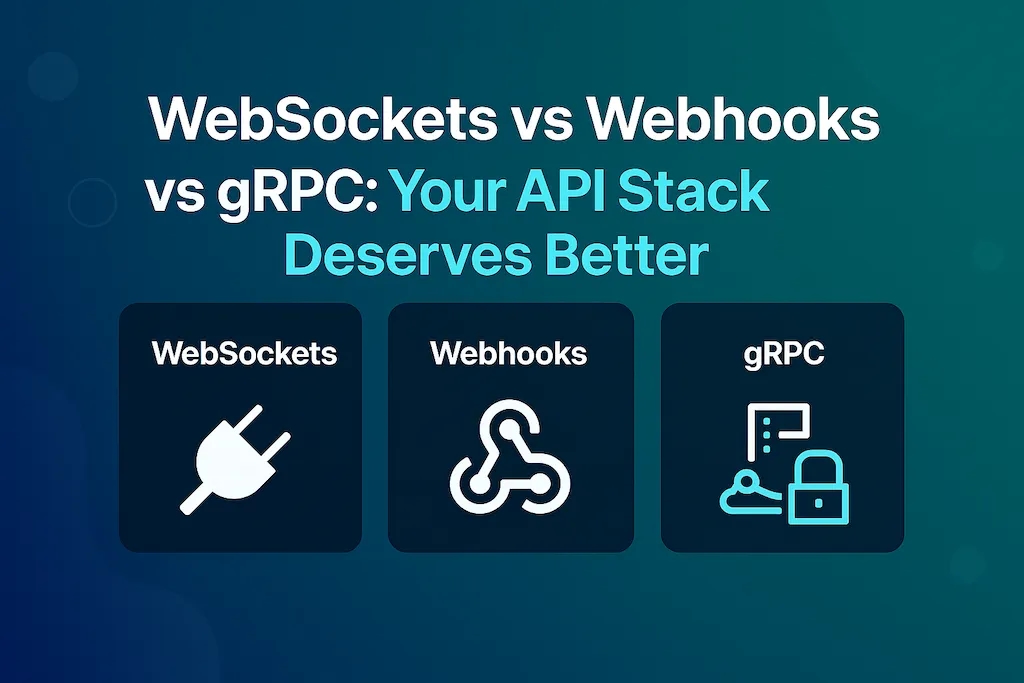WebSockets vs Webhooks vs gRPC: Choosing the Right Communication Protocol for Your Product
Author
Abhishek Uniyal
Date Published

In today’s API-driven landscape, teams are increasingly building distributed systems that rely on real-time updates, low-latency calls, and reliable message delivery. The choice between WebSockets, Webhooks, and gRPC isn’t just technical—it’s architectural.
This guide breaks down how they work, when to use them, and how to decide based on your product’s needs.
TL;DR: Quick Comparison

Mental Models
Still wondering which one to use? Let’s give your brain some metaphors to chew on:
- WebSockets: Like a phone call — once connected, both parties can talk freely at any time. (And yes, it's that friend who texts "hey" and immediately calls.)
- Webhooks: Like a voicemail — the sender leaves a message, the receiver picks it up when they’re ready. (It’s polite, asynchronous, and doesn't judge.)
- gRPC: Like a contract-based phone call — tightly defined language, efficient connection, used for structured conversations. (It’s that nerdy friend who schedules meetings with agendas.)
WebSockets: For Persistent, Real-time Conversations
Best for: real-time applications like multiplayer games, chat apps, trading platforms, and collaborative tools.
Node.js Example with ws:
import WebSocket from 'ws';const wss = new WebSocket.Server({ port: 8080 });wss.on('connection', (ws) => { console.log('Client connected'); ws.on('message', (message) => { console.log(`Received: ${message}`); ws.send(`Echo: ${message}`); });});
Client (browser):
const ws = new WebSocket('ws://localhost:8080');ws.onmessage = (msg) => console.log(msg.data);ws.send('Hello server!');
WebSockets are like that clingy connection you didn’t know you needed. Amazing for live updates — but don’t forget to babysit it. "WebSockets are fun until your load balancer ghosts your connection." Facts.
Webhooks: For Simple Event Notifications
Best for: triggering actions when an event occurs—without maintaining an open connection.
It’s like the server sends you a postcard every time something cool happens. This feature is particularly useful for facilitating clean hand-offs.
Example: Express-based Webhook Receiver
import express from 'express';const app = express();
app.use(express.json());app.post('/webhook', (req, res) => {
const payload = req.body;
console.log('Webhook received:', payload);
res.status(200).send('OK');
});
app.listen(3000, () => console.log('Listening on port 3000'));
Used by: Stripe, GitHub, Zapier, Slack, etc.
gRPC: For Fast, Strongly-typed Service Communication
Best for: internal microservice communication, mobile backends, ML pipelines, and streaming-heavy workloads.
gRPC is like REST with a gym membership: lean, fast, and shows up in protocol buffers.
.proto Definition
syntax = "proto3";
service Greeter {
rpc SayHello (HelloRequest) returns (HelloReply);
}
message HelloRequest {
string name = 1;
}
message HelloReply {
string message = 1;
}
Server (Node.js with @grpc/grpc-js)
import { Server, ServerCredentials } from '@grpc/grpc-js';
import { GreeterService } from './generated/greeter_grpc_pb';const server = new Server();
server.addService(GreeterService, {
sayHello: (call, callback) => {
callback(null, { message: `Hello ${call.request.name}` });
},
});server.bindAsync('0.0.0.0:50051', ServerCredentials.createInsecure(), () => {
server.start();
});
When to Use What

How We Use This at SynergyBoat
At SynergyBoat, we take a protocol-by-purpose approach:
- Webhooks help us track external event changes, like billing events, deployment triggers, and integration syncs.
- WebSockets drive real-time feedback in our analytics dashboards and AI-generated interfaces.
- gRPC handles internal service communication across our AI infrastructure, where performance and schema contracts matter.
Our stack is designed to be responsive, decoupled, and built for scale — and protocol choice plays a big part in that.
Final Thoughts
No protocol is objectively better—just more appropriate for the job.
If you’re building:
- Real-time UIs → WebSocket
- Event-based triggers → Webhook
- Efficient service communication → gRPC
Don’t use WebSocket where a webhook will do. Don’t gRPC everything just because you can. And please don’t ignore retry logic on webhooks unless you like late-night prod fire drills.
Your architecture should be boring and stable. Your product? That’s where the magic should be.
Want help architecting your event-driven or real-time system?
At SynergyBoat, we help product teams make reliable, scalable protocol choices across real-time, event-driven, and ML-first systems.